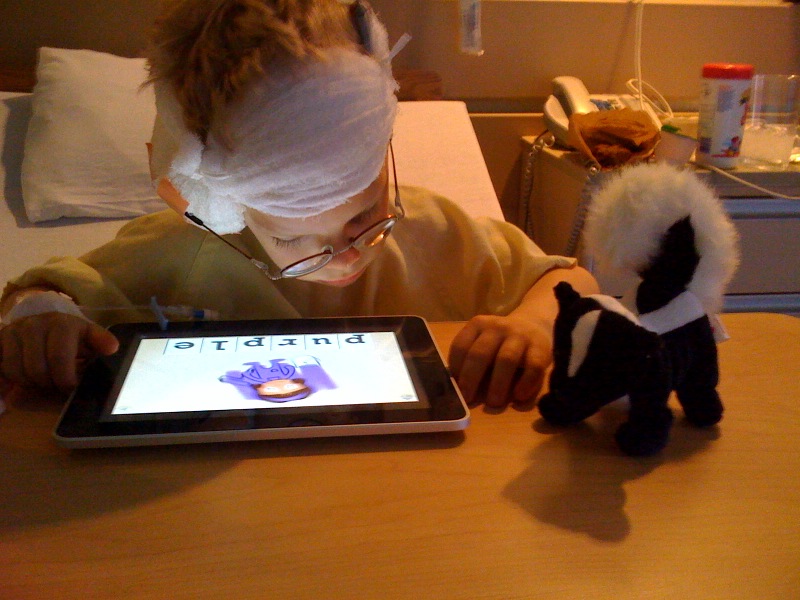Scott using an iPhone
When my son Scott first saw an iPhone, he was four years old. He’s a curious little guy, and if he sees something with a screen on it, his curiosity takes over. He took the iPhone in his hand, and started to use it. He did not play with it or examine it. He used it. It had taken him a few seconds to realize that he could drag and touch items on the screen. Within a minute he had found the photo application and was flipping through family pictures like he had been doing it for years. Apple’s intuitive design had almost completely removed the learning curve.
When you first learn to use a computer, you need to learn a new way to interact. Most of us didn’t take too long to learn how to use a mouse to manipulate a cursor on the screen, or learn how to use a keyboard to command a computer to perform an action. What we don’t realize is that our brain really needed to work hard to learn how to do these things – rewiring itself to interact using mouse and a keyboard. We accept this learning curve because in the long run, it gives us an efficient way of integrating technology in our every-day lives. The ubiquitous nature of the keyboard and mouse is great for the majority, but for those who have difficulty seeing, hearing, moving, or with learning itself, it can be a different story.
Touch screen interfaces rely on our inherent instinct to touch the things with which we want to interact. They require less motor control because the movements are not scaled down to match the size of a mouse pad, and they are not unrelated to the task, like those used to type commands on a keyboard. Both of these things reduce the time required to learn a task, and increase the confidence of the user.
Companies have been making computers that are modified or designed specifically for users with disabilities for many years, but given the small production volume, these units have been extremely expensive, rarely near the cutting edge of technology and without a wide range of software choices. All that changed this year when Apple introduced the iPad – a handheld tablet-style computer with a touch-screen interface. The device takes the touch interface familiar to iPhone users and scales it up to a size more useful for standard computing tasks. In making a computer that is amazingly easy to use, Apple has opened the door for people with disabilities to use the same computer as the rest of their peers. This alone is an advantage, especially for kids, who want little more that to fit in with their friends.
I felt a sense of normalcy and acceptance. Using an iPad, which could become as commonplace as the Blackberry and iPhone, is not yet another thing that makes me different. I wasn’t using a strange, unfamiliar device to communicate…
– Glenda Watson Hyatt (a writer with cerebral palsy)
The iPad costs around $500 for a base model. Compared with a cost of $5,000 – $10,000 typical of a touch screen laptop used by many kids with special communication or mobility requirements, it is easy to see why parents of kids with disabilities and the agencies that assist them are snapping up iPads as fast as they can. In the first few months of production, software developers have come up with hundreds of different applications meant to assist people with special needs, many of them at very low costs. There are signing and captioning applications for the deaf, high contrast and screen reading programs for those with vision loss, communication aides for people with physical disabilities, and organizational programs that are doing wonders for kids with autism. There are even devices on the market designed for attaching iPads to wheelchairs.
Let’s not kid ourselves. Tech companies don’t often design their products specifically to be accessible to people with disabilities. They are trying to bridge the digital divide by making their products attractive to a greater amount of people, many of whom would not normally be interested in high tech devices. The market for high tech products has traditionally been young and prosperous individuals, but as that market becomes saturated, companies will begin to target occasional and first time tech users. To do this, companies are making their products easier to use and more accessible. Ironically, it is the power users – the early adopters – who will appreciate these innovations just as much, since making things easier to use makes the whole experience better for everyone, especially those who use the devices the most
When Scott awoke from his second cochlear implant surgery, and had had a bit of time to figure out where he was, we handed him an iPad. He had been a brave little guy, and we had wanted to get him one since the product was announced. He was so happy he could watch a movie in his hospital bed, and his favourite spelling games he knew from the iPhone were so much easier to see on the bigger screen. His iPad is a valuable tool to help him learn at school, and a great comfort at the end of a busy day to curl up in a chair and look at family photos.


